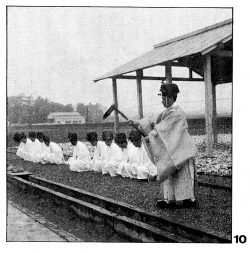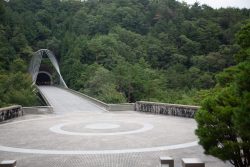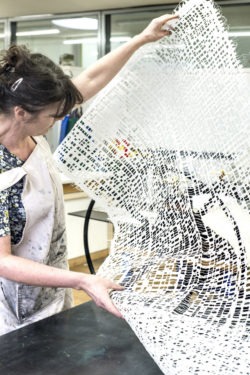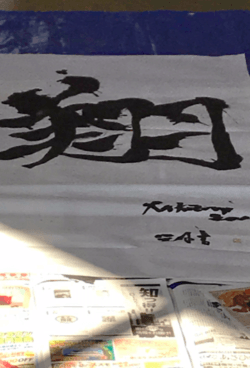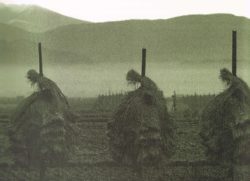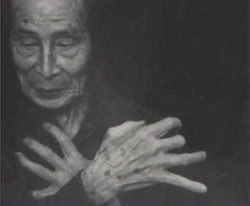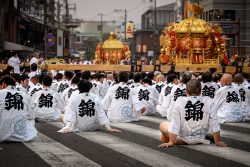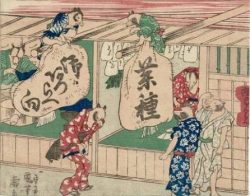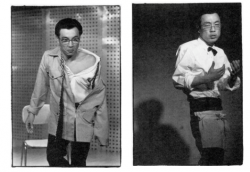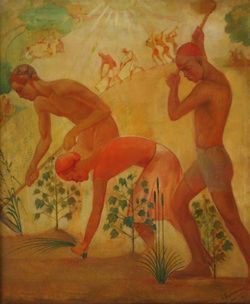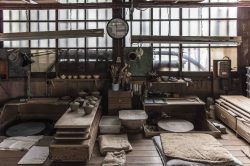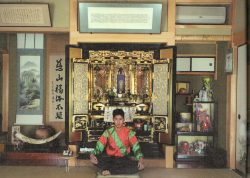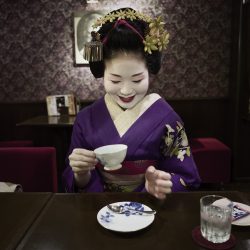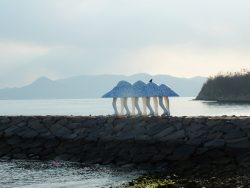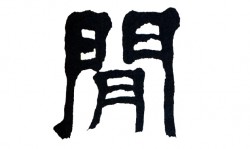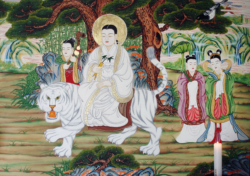Culture
Ima Tenko: Butoh dancer
Ima Tenko believes that transforming butoh performance from a big-budget spectacular, as it was with Byakkosha, into the intimate encounter she performs today is much more sustainable.
Read MoreDaijosai and Shikinen Sengu: First Fruits Twice Tasted: Renewal of Time, Space and Man in Japan
Through its rituals, Japanese society marks both historical time, that is, progressive irreversible time, and natural time, the cyclic eternal rhythm. Historical time was originally reckoned by counting the years from the enthronement of each emperor.
Read MoreBizen’s Past and Present at the Miho
With warm ochre blushes and the subtle textures of exposed clay, the ceramic style born out of Okayama prefecture’s Bizen is humble while retaining potential for visceral expression. The Fall show at the Miho Museum in Shiga prefecture, “Bizen: From Earth and Fire, Exquisite Forms,” running from September 14th through December 15th represents a rare occasion to view a diverse showing of Bizen ware and one which represents ceramic work as it evolved from is cultural emergence in the Momoyama Period (1573-1615).
Read MoreInspired by Japan
A look at the work of foreign artists inspired by Japan: Denis Guidone, Elaine Cooper, Alessandro Bellegarde, David Stanley Hewitt and Deborah Davidson.
Read MoreMastery of Movement
Shodō is the Japanese word for calligraphy. It means not just penmanship, but the Way, or Path of writing. In China and Japan, Shodō has long been regarded as one of the most important forms of art.
Read MoreNagata Yuji: Mysterious Makie Artist at the Miho Museum
KJ intern Codi Hauka visited the MIHO MUSEUM for the press preview of their latest exhibition: Discovering Nagata Yūji, Unsung Makie Master, on until July 15. Makie (蒔絵) is the craft of using gold, silver and other metal powders to decorate lacquered objects that include everything from sake goblets to calligraphy boxes. It was developed…
Read MoreLandscape of Memory
If one thinks of Japanese civilization as a great tree, the most brilliant blooms and succulent fruits adorned branches represented by the cities Nara and Kyoto. To fully appreciate those flowers and fruits one must follow the course of investigation right to the roots. These are firmly set in the soil of the inaka, approximately in English, ‘countryside.’
Read MoreA Child of All Time: Butoh Dancer Ohno Kazuo at 98
“The physical form I assume now is but the fruit of what I’ve inherited from those who have existed before me. What, you might ask, has become of our ancestors’ ideas and emotions? Where do you suppose our creativity springs from? There’s no way that it springs forth from our finite and limited knowledge of life.”
Read MoreKyoto’s Festivals: Twelve Months of Everyday Transience
In Kyoto, one grows accustomed to the ongoing round of festivals at Buddhist temples and Shinto shrines—it’s said that you could attend at least one every day here, throughout the year. But the word ‘festival’ doesn’t quite capture the spirit of the majority of these events. With some notably lively exceptions, they are mostly rather formal annual ceremonies and rituals…
Read MoreTanuki! Tanuki!
The popularity of the tanuki has much to do with its humorous and winsome image. With its plump body, awkward movements and simple-minded trickery, the tanuki presents a comical, safe and manageable impression compared to the cunning fox, the other trickster.
Read MoreEveryman with a Thousand Faces
Isse Ogata is a renaissance man in the stratified world of Japanese arts. On stage, his breadth and depth are unparalleled and his artistry shows the marks of genius: original, immediately recognizable, and impossible to imitate.
Read MoreHow to become Japanese: A Guide for North Americans
A tremendous amount of the stress of acculturation for North Americans in Japan arises from the interpersonal tension between their self-assertive and individualized selves and the self-effacing and collectively-minded Japanese.
Read MoreJourneys of Reverence: A daughter and mother’s decades on the Shikoku henro pilgrimage
In 1995, inspired by Oliver Statler’s Japanese Pilgrimage, we first set out on the 88 temples pilgrimage around the island of Shikoku, known as the Shikoku Henro, stretching over a distance of 1200 km.
Read MoreUpholding Lightness
Italian and Singaporean design duo Francesca Lanzavecchia and Hunn Wai on their latest collaboration, the challenges in taking advantage of new technologies, and the tools the next generation of designers need to navigate their ever-changing field.
Read MoreThe Museum of Forbidden Art
The museum’s obscurity, and Savitsky’s own lack of social standing or professional reputation in the art world, meant that no one in authority thought to look at what he was doing. Savitsky took the opportunity to quietly buy up the works of Russian painters who had been killed, sent to the gulags in Siberia, or otherwise fallen foul of the State.
Read MoreShokunin and Devotion
The Japanese word ‘shokunin’ is often translated as ‘artisan’ in English. Although it isn’t incorrect by definition, the translation seems to lose the spirit of what a shokunin does. I’m reminded of this every time I explain the works and lives of shokunin to an overseas audience, which happens to be what I do for a living.
Read MoreButsudan Boys
“Portraits of Eldest Sons” is a series of photographs addressing the relationship between young men and their family homes. Photographer Saito Hiroshi took indvidual portraits of himself and his friends—all young men aged around 20 or 21, and all eldest sons—in the rooms where their family butsudan, in-house Buddhist altars, are displayed.
Read MoreLiving Kagai Culture: Field Notes from Kyoto’s “Flower Towns”
The characters for kagai, Kyoto’s geiko districts, are often translated as ‘flower town’. Early in my research I began exploring this metaphor of a garden for the kagai’s cultural ecosystem. I soon discovered that, as in gardens, there are many layers, perspectives and influences.
Read MoreThe Art of Island Time
One element that visitors must not lose sight of when they attend the Setouchi Triennale is that the showcasing of art is almost secondary, or rather a “hook” in order to showcase the islands themselves. The goal is to raise awareness about the dire effects that depopulation has had on those insular communities that used to play a very important role in the social and economic fabric of this part of Japan
Read MoreMA: Place, Space, Void
Place is the product of lived space and lived time, a reflection of our states of mind and heart…
Read MoreGod in Pictures
I was baffled by her effort to pay homage to a large, framed (glass, metal) painted image of the mountain spirit (a wizened old man with a tiger and young attendant) that was up a pathway on the north side of Manisan Mountain peak, when we could actually at minimum address the spirits of the peak in front of us.
Read More

